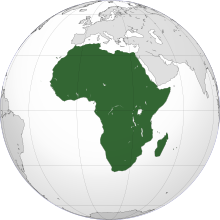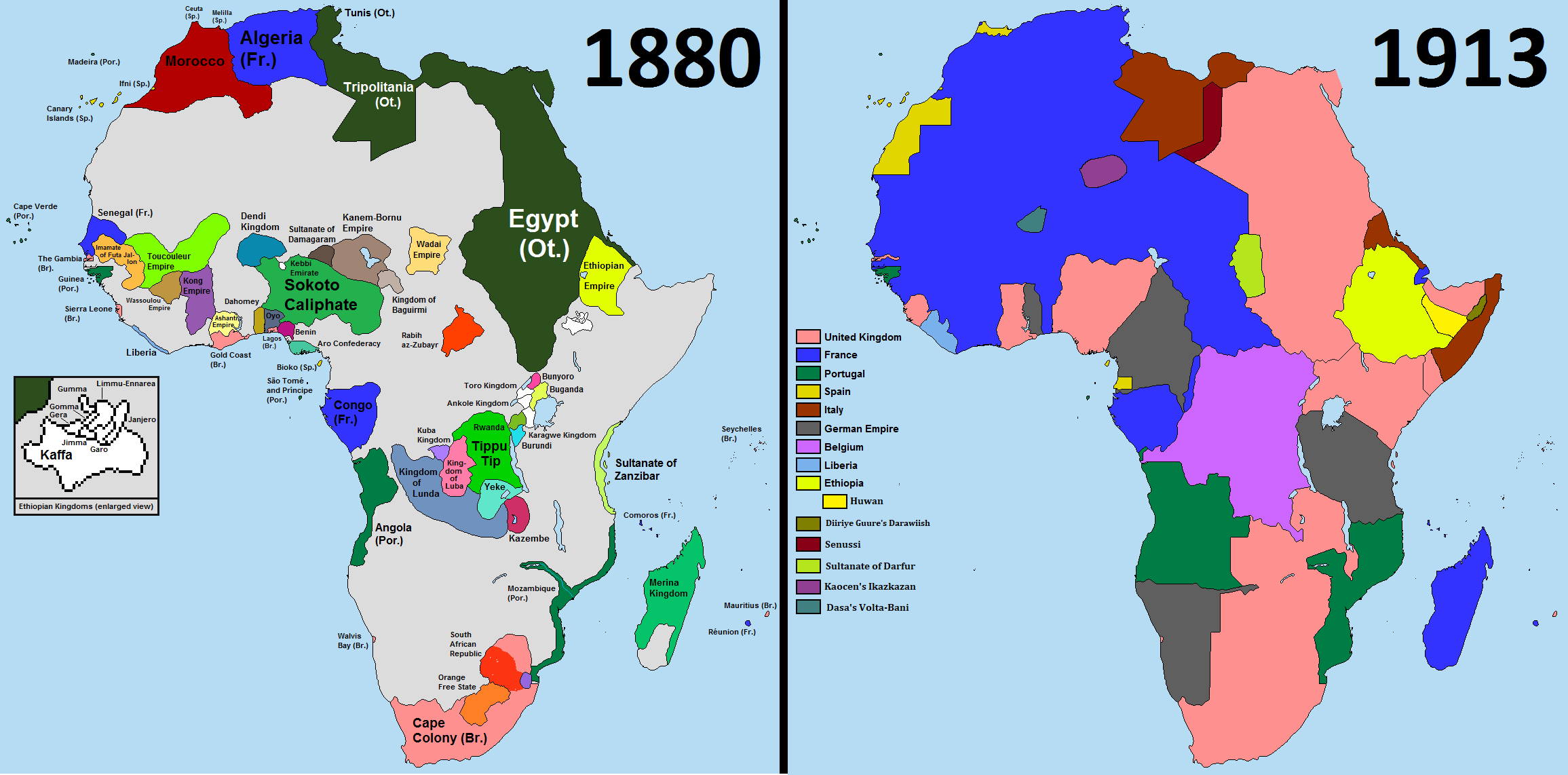More languages
More actions
Verda.Majo (talk | contribs) (added a little more to colonial history, added some basic info on post-world war two history and decolonization and necolonialism) Tag: Visual edit |
Verda.Majo (talk | contribs) (added to intro a bit, gave more detail about population, added section for Regions) Tag: Visual edit |
||
| Line 1: | Line 1: | ||
{{Infobox country|name=Africa|largest_city=Cairo|image_map=Africa Map.png|image_map_size=260|area_km2=30,370,000|population_estimate=1,275,920,972|population_estimate_year=2018}} | {{Infobox country|name=Africa|largest_city=Cairo|image_map=Africa Map.png|image_map_size=260|area_km2=30,370,000|population_estimate=1,275,920,972|population_estimate_year=2018}} | ||
'''Africa''' is the second-largest and second-most populated continent on Earth. To its north is [[Europe]], to its south is [[Antarctica]], and to its northeast is [[Asia]]. Africa is one of the most abundant areas in natural resources, as well as biodiversity. It has historically been one of the most [[Imperialism|imperialized]] parts of the world, and many African countries suffer from [[neocolonialism]] to this day. | '''Africa''' is the second-largest and second-most populated continent on Earth. Africa has a population of approximately 1.4 billion people, around 16.72% of the total world population.<ref>[https://www.worldometers.info/world-population/africa-population/ “Population of Africa (2023) - Worldometer.”] 2023. Worldometers.info. [https://web.archive.org/web/20230321052722/https://www.worldometers.info/world-population/africa-population/ Archived] 2023-03-21.</ref> To its north is [[Europe]], to its south is [[Antarctica]], and to its northeast is [[Asia]]. There are 54 countries in Africa, with [[Federal Republic of Nigeria|Nigeria]] being the most populous.<ref name=":1">Shvili, Jason. [https://www.worldatlas.com/geography/regions-of-africa.html “Regions of Africa.”] WorldAtlas. May 24, 2021. [https://web.archive.org/web/20221215111314/https://www.worldatlas.com/geography/regions-of-africa.html Archived 2022-12-15].</ref> | ||
Africa is one of the most abundant areas in natural resources, as well as biodiversity. It also has a wide variety of climate zones. It has historically been one of the most [[Imperialism|imperialized]] parts of the world, and many African countries suffer from [[neocolonialism]] to this day. | |||
== Regions == | |||
Africa is commonly divided into five major regions: [[North Africa]], [[West Africa]], [[East Africa]], [[Middle Africa]](or Central Africa), and [[Southern Africa]]. Northern Africa is the largest of the subregions by land area. East Africa is the most populous subregion of Africa.<ref name=":1" /> | |||
Africa is also commonly divided into North Africa and [[Sub-Saharan Africa]], with their location relative to the [[Sahara Desert]] serving to define the divide. A semi-arid belt known as the [[Sahel]] forms an area of transition between these two major zones. | |||
North Africa may also be grouped with the Middle East in certain contexts. This grouping is sometimes abbreviated as MENA (Middle East-North Africa). | |||
== History == | == History == | ||
Revision as of 06:01, 21 March 2023
| Africa | |
|---|---|
 | |
| Largest city | Cairo |
| Area | |
• Total | 30,370,000 km² |
| Population | |
• 2018 estimate | 1,275,920,972 |
Africa is the second-largest and second-most populated continent on Earth. Africa has a population of approximately 1.4 billion people, around 16.72% of the total world population.[1] To its north is Europe, to its south is Antarctica, and to its northeast is Asia. There are 54 countries in Africa, with Nigeria being the most populous.[2]
Africa is one of the most abundant areas in natural resources, as well as biodiversity. It also has a wide variety of climate zones. It has historically been one of the most imperialized parts of the world, and many African countries suffer from neocolonialism to this day.
Regions
Africa is commonly divided into five major regions: North Africa, West Africa, East Africa, Middle Africa(or Central Africa), and Southern Africa. Northern Africa is the largest of the subregions by land area. East Africa is the most populous subregion of Africa.[2]
Africa is also commonly divided into North Africa and Sub-Saharan Africa, with their location relative to the Sahara Desert serving to define the divide. A semi-arid belt known as the Sahel forms an area of transition between these two major zones.
North Africa may also be grouped with the Middle East in certain contexts. This grouping is sometimes abbreviated as MENA (Middle East-North Africa).
History
Antiquity
West Africa
Starting around 1000 BCE, trade routes connected West Africa to the Mediterranean Sea. Africa traded gold, iron, salt, ivory, and slaves northward while knowledge of iron tools and cattle herding spread to Africa from Europe and Asia. Ironworking began in the Nok culture of Nigeria as early as 450 BCE, and advanced pottery also developed around this time. Bantu-speaking migrants spread cattle and iron to East Africa in the late first millennium BCE and then spread into Southern Africa by 500 CE.
The Ghana Empire, which extended across 800 km of West Africa at its peak, constructed the trading town of Jenne-Jeno on an island in the Niger river around 400 CE and surrounded it with a 2-km brick wall.[3]
East Africa
The Kingdom of Kush controlled much of what is now Sudan between 900 BCE and 325 CE and defeated Egyptian, Greek, and Roman invaders before being overthrown by the Ethiopians. The state of Axum on the Red Sea became an important trading power and remained Christian during the Islamic conquests.[3]
Middle ages
Arab influence spread across Africa between the eighth and 12th centuries CE. The Arabs established trading settlements such as Kilwa on the eastern coast of Africa and enriched the town of Timbuktu. Between 1200 and 1750, a series of trading states include the Mali and Songhai empires rose and fell in West Africa. Coastal trade also fueled the East African civilization of Great Zimbabwe, whose economy relied on cattle, gold, iron, copper, and tin. African civilizations largely depended on outside trade from 1000 until the European invasions that began in the 15th century.[3]
European colonialism

During the Long Depression, European powers greatly increased their colonial efforts in Africa in order to obtain raw materials and new markets. The percentage of Africa under European occupation grew from 10% in 1876 to more than 90% in 1900.[4]
From the 16th to the 19th century, nearly 13 million African people were trafficked across the Atlantic Ocean in order to be enslaved in the European settler-colonization projects in the Americas, in what is known as the Transatlantic slave trade. The slave trade had devastating effects on African societies as well as on the enslaved individuals who were trafficked out of Africa as well as on their descendants living in the enslaving regimes even after the transatlantic slave trade itself gradually decreased and eventually became illegal.
Summarizing the history of West Africa, Kyeretwie Opoku, convener of the Socialist Movement of Ghana (SMG), summarized European colonialism in Africa and the changes it underwent over time in order to facilitate monopoly looting of Africa's resources and to forestall a European war:
When slavery became impossible because of African resistance and significant shifts in North American capitalism, imperialism transitioned West Africa to colonialism. Europe carved up our entire continent brutally and inorganically to facilitate monopoly looting of our resources and to forestall a European war. Our transported brothers and sisters, once slaves, became oppressed second- or third-class citizens in the Americas in their new countries. We who remained in Africa were deprived of sovereignty and made second-class citizens in our own lands. Imperialists reorganized our societies in many overt and subtle ways for their profit and to limit our will and capacity to resist. But resist we did. And we were slaughtered by what we are now pleased to call our “Development Partners” in the interest of European Capital. And then, comrades, imperialism plunged the world into two disastrous world wars.[5]
World Wars
See also: First World War, Second World War
Decolonization and neo-colonialism
The movement for decolonisation and independence in Africa saw rapid change after the conclusion of the Second World War. Numerous African countries gained independence from the former colonial powers at this time, although in many cases, the independence was disingenuously recognized by Western imperial powers who sought to retain their economic and political dominance of Africa through neo-colonialism. Additional tactics of subversion via intelligence agencies and outright violence and the staging of coups d'etat were also employed by Western capital in suppressing full African independence.
Kyeretwie Opoku describes how imperialism in Africa "staged a tactical retreat to neo-colonialism" after European capital became weakened in the First and Second World Wars:
These wars restructured global capitalism again, leaving European capital too weak to repress African resistance, exclude other capitalist states, especially the US, and remain profitable. Imperialism, therefore, staged a tactical retreat to neo-colonialism, under which African exploitation and oppression continued, supervised now by treacherous imperialist-socialized local elites wielding Western-designed institutions—a sop to popular demands for liberty. We have endured and resisted neo-colonialism for almost 70 years now.[5]
The rise of the Bretton Woods Institutions such as the International Monetary Fund and World Bank provided some of the methods for neo-colonial impositions on Africa. For example, the debts contracted with the World Bank on decision of the colonial powers, Belgium, Britain and France, in their African colonies, were subsequently imposed on the new countries at the time of their achieving independence.[6]
Geography
Africa is roughly 7,500 km long and runs from north to south, passing through coastal plains, deserts, savannas, and tropical forests. Major rivers in Africa include the Nile in Egypt and Sudan and the Niger in West Africa.[3]
References
- ↑ “Population of Africa (2023) - Worldometer.” 2023. Worldometers.info. Archived 2023-03-21.
- ↑ 2.0 2.1 Shvili, Jason. “Regions of Africa.” WorldAtlas. May 24, 2021. Archived 2022-12-15.
- ↑ 3.0 3.1 3.2 3.3 Neil Faulkner (2013). A Marxist History of the World: From Neanderthals to Neoliberals: 'The Medieval World' (pp. 69–70). [PDF] Pluto Press. ISBN 9781849648639 [LG]
- ↑ Neil Faulkner (2013). A Marxist History of the World: From Neanderthals to Neoliberals: 'The Age of Blood and Iron' (pp. 166–167). [PDF] Pluto Press. ISBN 9781849648639 [LG]
- ↑ 5.0 5.1 Kyeretwie Opoku. "We Must Unite Our Continent." Peoples Dispatch. December 12, 2022. Archived 2022-12-18.
- ↑ Toussaint, Eric. 2022. “World Bank and IMF: 76 Years Is Enough! Abolition! – CADTM.” CADTM. August 11, 2022. Archive.
